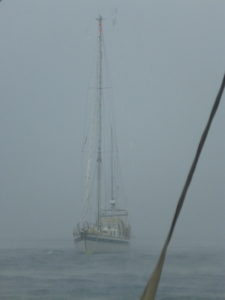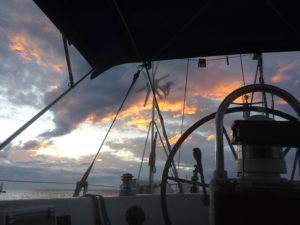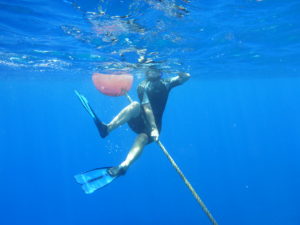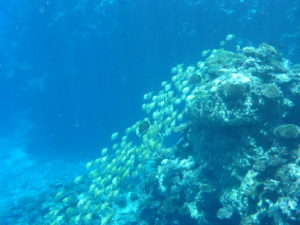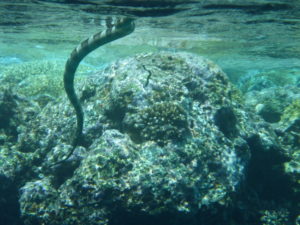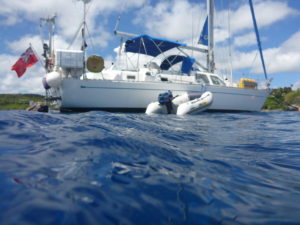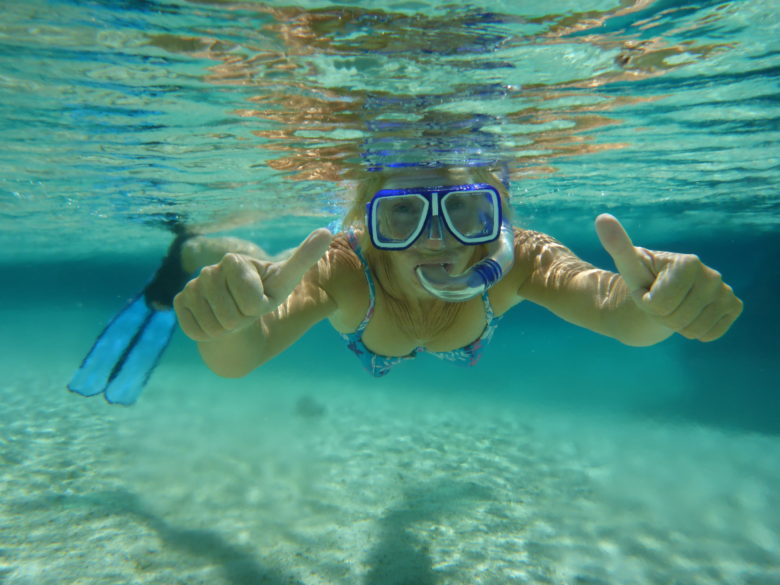19:03.30S 169:55.45N. Basking with whales
Following the gale the winds remained in the high twenties giving us nice daily mileages but as we approached the biggest lump of limestone rock in the world that is Niue we realised we needed to slow Zoonie down to make a first light approach, and we are glad we did as two surprises met us on turning the corner towards the west side where the mooring field is located off the main town of Alofi.
We had heard the humpback whales from the Antarctic come to the area from May to October to have their babies and often meander through the mooring field with their newborns. But to be greeted with the not too distant view of three was a gasping thrill.
They took turns to breach, rising at speed from the depths nose upward into the air, their white throats with darker grooves bright in contrast to their bodies, which slowly arched downward to one side as they hit the water with a mighty splash. Wonderful.
The second surprise was a number of red fishing buoys with what looked like the floats that keep the top of nets near water level tied close to them. Either they were full with fish ready to be collected later, or they were being stored there. To arrive at night and get tangled up in one of these unlit traps would have been a sorry end to any cruisers passage.
Fishing methods appear different almost everywhere we go. Early morning and late evening darkly clad men in dark coloured piroque canoes would be sitting hunched over in their canoes around us. The sole occupant would chew something, maybe bread, roll it into a ball and drop it into the water near the canoe and then tap the side of the canoe to attract the fish. We have been told they are bait fishing but we have as yet to see them catch anything!
Concerned that as the seasons draws on and cruisers are now accumulating around the islands ready to find safe havens for the cyclone season there may not be any mooring buoys available, we were doubly thrilled to find only six of the eighteen buoys occupied. We would not have to move on having come so close to this unique gem of an island.
Rob looped one of our stout mooring lines through number 3 buoy, and then did the same with another so we had two separate lines running down as a bridle from both sides of her hull, and backup should one wear through.
As soon as we’d pumped up the dinghy we motored ashore to meet the Customs Officials. It was hot. Even the locals thought it was hot. I love this life and its daily new adventures. Today’s was lifting the dinghy up onto the hard, out of the damaging swell using a crane.
There was first the limestone reef that skirts close inshore around the island to negotiate. Then there is a tiny channel across to the harbour wall. As Rob positioned the dinghy I grabbed the yellow hook and secured our hoisting ring to it. Then we both got pretty wet in the swell getting ourselves ashore. Rob then dashed to the controls on the upright of the crane and I held the painter to have some control over our little rubber duck.
Up she goes and once clear of the wall I pulled her in and Rob lowered her onto a little trailer. We then disconnected and lowered the hook once more for the next punter. Tenders have their own bays, so we ‘parked’ her out of the way and returned the trailer.
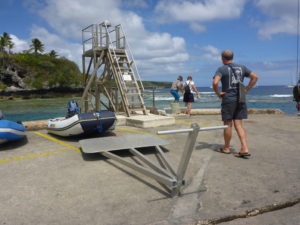
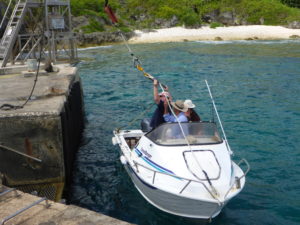
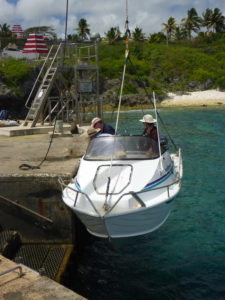
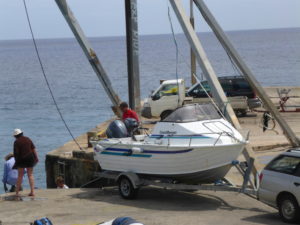
Fortunately some kind person had the forethought to provide a roofed shelter, so we sat in the shade with the male and female customs officers, filling out forms on the wooden bench while watching a mother humpback show her baby how to breach, a few metres offshore.
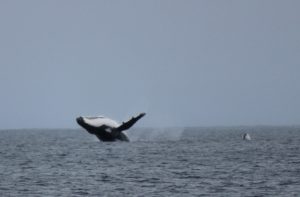
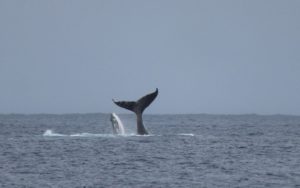
The young male officer dashed off for a moment to deliver a fridge to a friend and when he came back told us, “Young people from the island go to University in New Zealand and then the government offers to pay their tuition fees if they will return to the islands to take up public sector jobs. We work until 4.00pm each day and have steady secure jobs with pensions etc. When you check out you must call us on Monday, Wednesday or Thursday as we don’t work weekends and we are at the airport for the Auckland flight on Tuesdays and Fridays, ok.”
“If the flight is full it takes us a long time and we may finish after 4.00pm.” (Oh dear.) “Some of the people stay at the new hotels on the south west corner near the airport. They have been built since the last cyclone in 2005. They won’t survive another cyclone and we are overdue as bad ones come every ten years. I feel sorry for the owners, the winds and tsunami will destroy their hotels.”
The cyclone season starts mid-November, by then the whales will be back in Antarctica feeding and breeding and the mooring field empty, the cruisers having found their hurricane holes elsewhere.
Rob guided me by the hand up the steep harbour road as my head was bent over my shoulder watching the whales, passing massive new concrete sinkers, ready to have their lines and mooring buoys attached. From the size, about three quarters of a metre square and half a metre high, we were reassured of the security of the vessels attached to the buoys offshore.
First stop was the yacht club to sign in as they provide the moorings, so we will pay them before we leave.
Then we went to tourist information as usual and gathered lots of info to read at our leisure back on board.
Lunch was novel. The chef was also the fisherman, and the Falala Fa Restaurant had been recommended as the best place for fish and chips in town. The chef also believed in ‘first come first served’ because even before he opened up on the day he had sold all the fish and chips as ‘takeaways’ to some builders.
Nuie boasts a unique cuisine, which is clearly much harder to find than the whales. The menu was mostly burgers or chicken and chips. Ah but hey they have a vegeburger. “That will do nicely,” I said.
We happily supped our canned beer and laid plans for our stay. The lady in tourist information advised us to book our car soon before they are all booked for the week by the passengers on the Friday flight. So we decided to do that after lunch.
Which duly arrived. ‘My vegeburger’ consisted of a burger bun stuffed with salad and a salad on the side. Well I couldn’t argue it wasn’t vegetarian but the literal translation of vegeburger went a little too far for me. Too astonished and amused, I just ate it and pinched a few of Rob’s chips to add variety.
Around in the commercial centre are all manner of tiny but useful businesses from art gallery to internet café, Indian restaurant, PO and bank, hair salon and beautician (all the same lady, Sala), boutique and supermarket.
“Would you like an appointment or shall I cut your hair now?” Sala said.
“Now would be great,” I replied and Rob went off to book the car. Time management is important even in retirement you know!
As she made a lovely job on my hair our conversation ranged from her recent trip to London and Paris, the former she loved and the latter she found the people unfriendly, to why there are fewer whales in the bay this year, “Nature” she said when I asked her why.
We’re still getting used to everyone speaking English (and their own Niuean tongue which is often interspersed with English and makes it hard to eavesdrop!) The last time the locals spoke English as their prime language was in……..England!
Back on board we read the pamphlets and brochures and came up with a few ideas. There were small vanilla plantations all over the island before the 2005 cyclone Heta destroyed many of them, and, disheartened some farmers burned their own ruined acres. However in 2011 Niue Vanilla International was established to encourage farmers to revive this lucrative industry with its global markets.
Great, we thought, at last we will get to understand the complex process of processing vanilla legumes into products. Bees don’t know how to pollinate vanilla flowers, so the farmers must do it in the 12 hours only of each flower’s blooming time. Due to climate change the vines now flower all year round, so the potential availablility is very strong.
However the lady that shows visitors around her plantation was away, as was the man who is starting a new plantation and also owns our car hire firm. So we were thwarted in that plan.
Similarly many of the beautiful cave formations around the islands with colourful rocks and stalactites and stalagmites are privately owned and the only access is with the owner as guide. One such owner was taking two months off to help his family to build a restaurant, so a rethink was needed there.
Disappointed so far we turned around to find our Austrian friends we met in Bora Bora, Christina and Werner from their Catamaran Wind Dance standing behind us. They had taken a more southerly route than us and missed most of the gale. After a short chat they showed an interest in joining us for our two days of car hire. We had managed to book an afternoon with a group who take folk to snorkel on the sheltered outer reefs at the south of the island and to swim with Spinner Dolphins (unless they aren’t around that is) and left it with Chris and Werner as to whether they wanted to do this with us.
The lady had marked on our map all the best sights where we could walk on reefs and snorkel in caves around the island, so that would do for day two of the car hire. Unfortunately the Huvalu Forest we were advised was not accessible by walkers and forestry workers were constantly busy in there, but we spotted a bike route through it so surmised we might be able to walk that track a little way.
It has rained a lot since we have been here so we thought the tracks might be muddy, but as the only veg on the island is grown hydroponically there would appear to be little soil depth. Humanitarian aid, tourism, the usual government and service industry jobs and government aid seem to be the main income of the island, along with the many small businesses and a few farms and plantations. I will know more after our two day tour.
The islanders all have dual nationality, New Zealand and Niue but are self- governing with strong links to NZ. The local govt has its own cunning ways of raising a few extra dollars. To drive on the island one must have a Niue driving licence ($20) which is only obtainable on week days. Visitors can drive without one at the weekends as long as they trundle down to the police station on Monday and buy one. All in the interests of road safety, I don’t think.
There is also an exit tax of $34 per person, they’ve got you there as everyone has to clear out officially, so must pay. If clearing in over the weekend there’s a surcharge of $20 to get the guy out of his house!
More of the people we met in Bora Bora have arrived, Austrian Hannes and Sabine, who was astonished we swam with the lemon sharks, have arrived and more of the buoys are being taken up. We’re so glad we arrived when we did. We are now in the company of the Swiss, Swedish, French, Austrian, German and Australian cruisers, the latter coming from Bahia in Ecuador like us with their own stories to tell of Tripp and his family.
There is a market on Tuesdays and Fridays, so we were speeding towards the harbour before 7.00am one morning with a short shopping list in mind. Bread, tomatoes and fish.
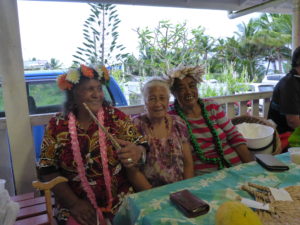
The market is a fine new roofed building with open sides. Locals sat around in happy groups chatting and smiling at us, their home grown produce on the tables in front of them. “Is there any fish for sale?” I asked one lady.
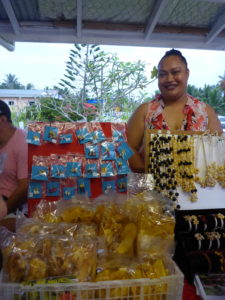
“That lady over there has flying fish.” She replied. We noticed coming over how enormous are the local flying fish, obviously skilled at eluding their predators. The lady showed us her collection in a portable freezer. The size of a medium trout and at £1 each we bought five. “How you going to cook them?” She asked.
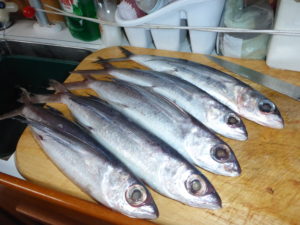
“Em’, poisson cru and maybe fried after filleting?” I ventured, she nodded. “How do you catch the flying fish?” I asked.
“With big nets.” Sounds obvious but I wondered whether that would be with big nets under the water or as they fly through the air. We had ‘caught’ some of their massive scales on board but the fish had all managed to get back into the water.
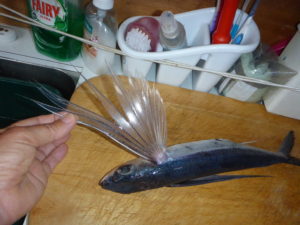
I made the poisson cru the day before yesterday by soaking raw bite-sized pieces in lime juice in a pot in the fridge overnight. Just before serving I added chopped colourful veg, this time some of the tasty baby plum tomatoes we had bought in the market and cucumber to the mix and tossed it with coconut milk. We had it for lunch served with white rice flavoured with some of the vanilla paste bought in the Chinese supermarket in Bora Bora.
In the evening we had the rest of the fish in a tasty sweet and sour sauce Rob had made beforehand with toasted garlic butter baps. The weather all around was grey and dreary so we thought we’d have some cheery food on board.
A few days ago I started up my patent washing system. Two big buckets, one for coloureds and the other whites. Half-filled them with Zoonie’s always blisteringly hot water and some wash liquid and then the washing. Crammed on the lids and left them overnight as Zoonie gently rocked them on an oceanic wash cycle.
The next day we hung it all out on deck and went off ashore, firstly to tourist information to confirm the car would be big enough for four. It started to rain but in this temperature we were not worried about the washing as it would dry quickly anyway, so we visited the yacht club and used the Wi-fi and then had a delicious lunch of wahoo fish and chips at the Crazy Uga Café overlooking the bay which came and went in vision in the rain showers. Then along to the Bonded Warehouse for some duty free gin and brandy, the first since duty free at Panama! Wonderful.
Back on board we moved the washing to under the bimini roof but during the night the wind got up so before 1.00am we rallied ourselves and brought it inside. I was curious of a torch light making its way along the shore inside the reef. Every now and then the holder shone it up into the overhanging limestone cliffs and in so doing revealed the silhouette of his lanky form. Intriguing. Smuggling I dismissed, more like looking for bats, or Rob suggested birds eggs, but it’s a mystery and I like to solve them, so watch this space.
Awake now we sat in bed drinking a cup of tea and nibbling on digestive biscuits, well we were going to change the sheet in the morning so I didn’t think the crumbs would matter.
And what a morning. We hadn’t been up long when a family of humpbacks, possibly our reception committee, came close to our side of the mooring field and gave a fantastic display of breaching, tail slapping, spy hopping (elevating far enough out of the water so the eyes can see around) and fluking the tail before a dive.
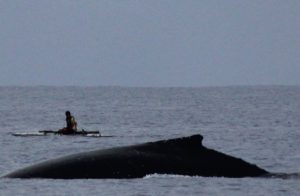
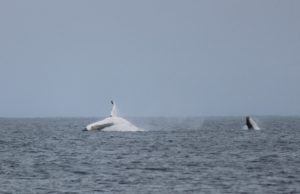
My Canon was set on repeat so I was able to get a sequence of shots including the calf copying its parent. The chap from the boat next to us was returning in his tender and just stopped and watched in awe at the wonderful sight.
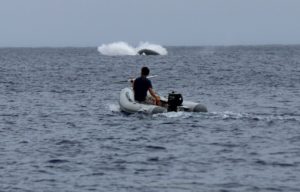
Four days on Niue.
Sunday 11th September. Grey skies and later rain. We went in the dinghy to visit Werner and Christina on Wind Dance iii and were kindly entertained with freshly made coffee and an early light lunch.
Christina regailed us with stories of the four lost yachts on the Tuamotus so far this year and then the disappearing sailmaker.
One of the yachts’ single handed skipper had died while under way and his yacht delivered him onto a reef. Later we heard that he had re-located and fortune in his business dealings and his body disappeared, maybe not so dead after all. Another was manned by two young men who had fallen asleep and left the autopilot to do the work. A third yacht suffered careless navigation and a strong current, causing it to mount a reef and another fell foul of the warning not to arrive near the reefs at night.
As for the sailmaker, I really felt for these sailors. They left their suit of sails to be inspected and repaired, and paid a deposit, only to return and find the sailmaker had disappeared, his workshop cleared of all items, their sails included.
We had intended to go ashore to stretch our legs but the weather looked so threatening that we returned to Zoonie’s welcoming saloon with the knowledge that Werner and Christina would join us for the second day of our car hire.
Rob tried in vain to get a signal from overhead satellites so we could send emails and a blog but for the first time ever they seemed to be passing us by.
How to catch a flying fish.
Take a small boat with motor, a few torches and a large scoop net. After dark motor gently out into the bay, turn on the torches and aim the beams just ahead of the slowly moving boat. Wait. Catch the flying fish as they leap away from the boat, as one would butterflies on an English summer’s day. There, mystery solved.
Mystery of the nocturnal cliff scourer.
He was most probably hunting coconut crabs for a tasty supper! We see them often, scampering up or down their hiding places. Second mystery solved.
Monday, number 1 car day.
Opaahi Bay is a tiny double bay which is constantly used by local fishermen. They store their beautiful little pakas (piroques or outriggers) either side of the rocky path leading down to the natural gulley dividing the shore hugging reef. Each Paka has a palm frond lying over the seat area to keep the wet out of these solid wood canoes. They are works of art and love. The single canoeist goes out in the early morning or evening, at half-light. With a hand line he catches small fish, to be used for bait, with the dough balls he has softened in his mouth. He taps the side of the paka to attract the fish and keeps them in the ruck sack on his back.
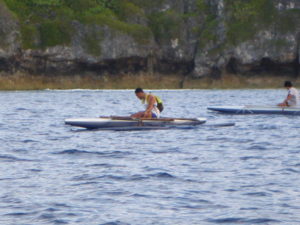
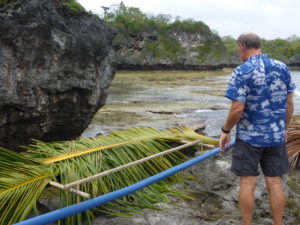

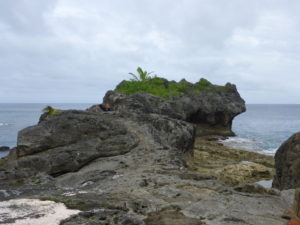
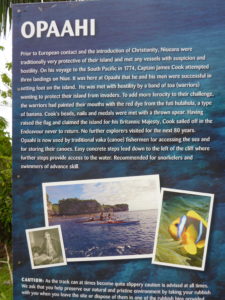
Standing at the foot of the path, overlooking the bay we were in the position of the painted warriors, armed with spears and clubs, who in 1774 were confronted with eighteenth century sailors, led by Captain Cook, attempting a landing from their brig, Endeavour anchored just off the reef.
What can they have thought about these foreigners? In two other parts of the island Cook’s attempts at landing had been successfully thwarted, but here the chief may have been more lenient or perhaps curious. After a short stay and the unwelcome offering of beads and medals as gifts Cook sailed away, doubtless to the pleasure of the warriors who were unaware Cook had claimed the island for the English crown, an act that may seem arrogant today but appeared to be the royal dictate at the time. No other Europeans visited for 80 years.
All around this limestone island, its coastline measuring 64km, are deep chasms, caves, pools and sea tracks (walks along the shore hugging reef) and we visited Anapala Chasm, with its 155 carefully crafted steps and sturdy chain link railing, supported by posts all the way down.
To get to the start of the trail we drove across one of the many wide open grass areas at the centre of a small village each with a well-kept church. Most of the tiny, prefabricated houses are now derelict. Some have vehicles and motor bikes parked alongside, as if the residents pulled up for the last time and then simply left. The homes and vehicles are rotting away together, their only company the graves of the ancestors in front of them.
Where the odd bungalow is still inhabited the graves are well tended. One mausoleum had a picnic table alongside, giant speakers within, lights all around the roof and a barbecue close by. Clearly the family liked to include their dearly departed in their al-fresco suppers.
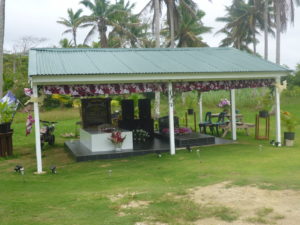
In 2005 a severe cyclone hit Niue, devastating their plantations and destroying everything in its path. So not only did people leave their wrecked homes and livelihoods, as Rob said many must have died.
We drove through thick brush to arrive at the little car park and set off through the limestone undergrowth to the chasm steps. The narrow weaving path meandered through great chunks of limestone on each side. In the shallow soil ferns and small trees thrived and low plants with purple leaves (that we keep as houseplants in the UK) created a beautiful rock garden.
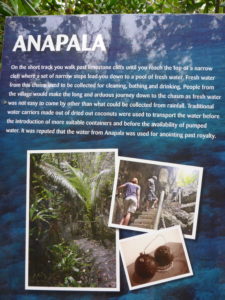
Remembering the many steps to Machu Picchu we didn’t think these 155 steps would be too much of a challenge. As we descended the sound of the roaring waves on the reef disappeared and suddenly a high, narrow cleft in the rocks rose above us. We could see a slither of daylight at the other end and in between a pool of pure freshwater. Historically used by the locals who carted the water to the village in coconut shells, we had our drink from a plastic lid I had in my bag before clambering up to the limestone garden once more.
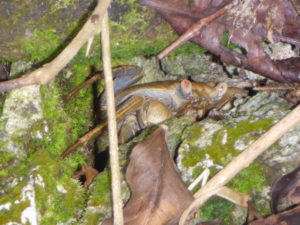
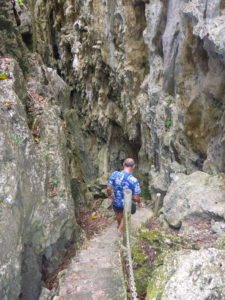
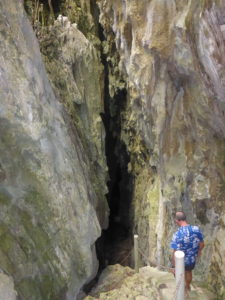
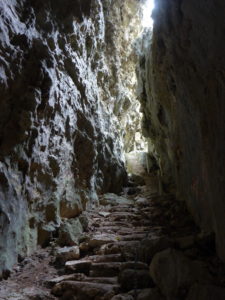
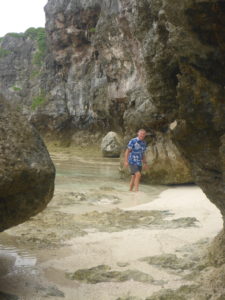
There are a few ‘bush’ roads on the island, suitable for mountain bikes and we walked into the Vinivini Bush Road just to get a sample of the Huvalu Forest, which is located on the central plateau of the island. A disused limestone quarry with a rusting CAT bulldozer, which must have provided rock for roads, lay to one side and areas of low brush suggested that beneath were what had been plantations in the past.
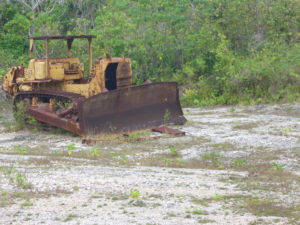

We had an early lunch above the Liku Sea Track as we had booked a snorkel trip for the afternoon. Arriving early we completed the formalities and wandered through to the Makavai Resort for a Cappuccino overlooking the bay next to the one we were moored in.
The weather was cool and grey as we watched a mother whale feeding her two week old baby in the water below. A couple, who later introduced themselves as Andrea and Mark from Auckland, New Zealand, were also interested. They turned out to be the other couple on the trip and along with Gary, whose wife watched our antics from the balcony of her hotel room above us, we were complete.
Israeli David was our guide. We had been watching this female whale from on board Zoonie over the weekend. She would suspend herself with just her flukes above water so her calf could feed easily rather than having to suckle her from below. This is very rare behaviour, only seen in whales off the eastern shores of Australia. She will have learned it through copying other mothers as her group mingled with another group from E Australia, or from her own mother.
“She’s a great mum, she gives her baby 500 litres of thick, pink milk each day, it’s the consistency of toothpaste,” Dave said as we circled her quietly from a distance of 100 metres, “In two months he will be half her size and only then big and strong enough to move on to Vavau. Niue is only a station, the whales pass through here, leaving as and when their young are big enough.”
I had been watching the heavy swell breaking over the reef, inshore of us in a line of magnificent white/turquoise rollers, wondering where our ‘safe’ snorkelling spot would be. I thought that if its anywhere near those crashing hills of water then I’m NOT game!
The whale does not like having dolphins near her while she is feeding so thankfully for her and us we moved to the far end of the bay and spotted some spinner dolphins coming over to what was by now a routine daily visit from the rib in calmer waters.
Wet-suited and flippered, snorkels in place, we took it in turns, one on each side of the rib, at Dave’s word, to slip over the side, holding a rope loop as he motored us slowly forward with the dolphins leading the way.
At last my turn came and with it the realisation of the beautiful 3D world of these friendly creatures. As soon as my head looked beneath the surface I saw dolphins all around and down into the depths below. One was sniffing another as if she was maybe on heat. Rob said later that he saw two mating, belly to belly. Two foot long babies swam and skittered about with the adults.
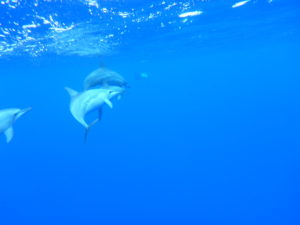
I looked down as a single dolphin spun around ascending directly towards me. At my level it turned, looked me in the eye and swam with me just out of reach. David called to me and Andrea on the other side to say “Hold tight we are going to catch them up.” Both hands holding on as we sped up to their cruising speed.
After a few minutes of this we picked up a little buoy and dropped over the side for a short snorkel. To be honest, with no sun and a grey sky the coral garden was not at its best and we were not sorry to make our way back to the hoist at Avatele Beach where the truck and trailer awaited us.
We had been three hours in cool air and despite our wetsuits I was chilled and famished. Just before we left Andrea and Mark gave us their address and offered us their spare room should we visit Auckland. We gratefully accepted and look forward to getting to know them better, as it turned out a lot better later on.
Gill’s Indian Restaurant in Alofi main town was the only eatery open but it did us fine and the cold canned beer hardly touched the sides.
Tuesday, Number 2 car day.
Werner and Christina picked us up and we made our way to the hoist once more. The weather had improved and blue skies escorted us to Palaha Cave, a big cave with thick stalactites joining roof to floor like the columns of St Paul’s Cathedral. Using the camera flash sometimes brought out the colours of the dissolved minerals better than the naked eye.
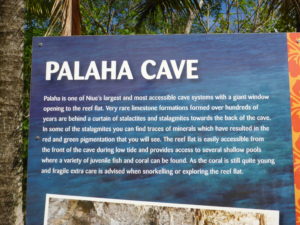
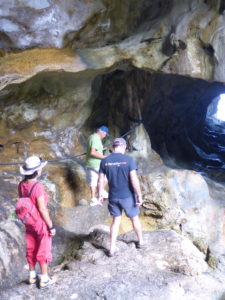
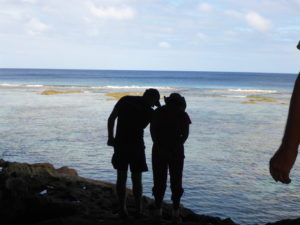
The family with three young daughters from the catamaran moored next to us arrived. One of the girls ran sure footed through the cave, her mum holding her flip flops and later dad lifted them all onto a higher floor, like an attic, which to their delight they had all to themselves.

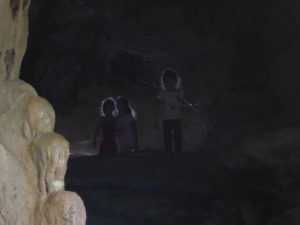
The cave opens out through a vast window onto the shallow biscuit coloured reef and the turquoise sea beyond. In tiny round rock pools fish, sea cucumbers and crabs awaited the next high water and beneath our feet strange thread like creatures emerged from tiny holes and undulated across the pink rock.
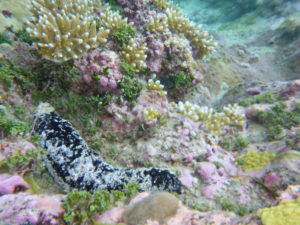
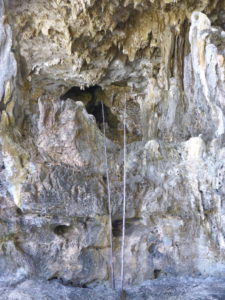
We returned to the car being careful not to snag on the enormous spiders’ webs that traversed the steps, some occupied and all evidence of the sheltered area they were suspended in.
It was time once again for snorkels and flippers at the Limu Pools. At low tide these are cut off from the sea and provide safe areas for swimming and the like. Cold fresh water streams flow in and shocked the skin as we swam by. The fresh water also causes one’s vision to blur as it mixes with salt water making photography a challenge.
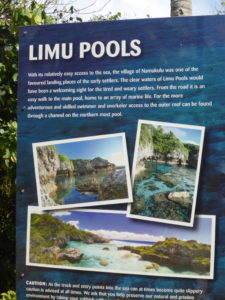
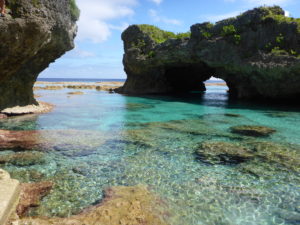
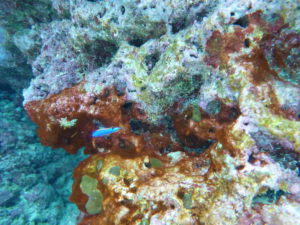
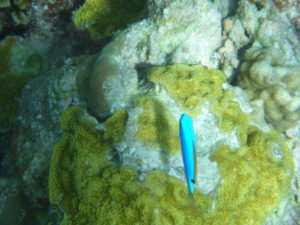
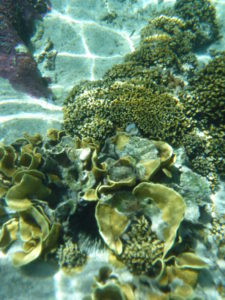
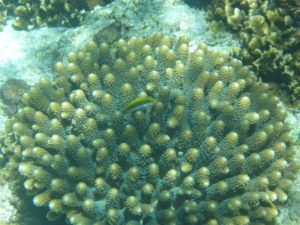
New steps are being laid covered with textured fibre glass to make access safer. The man working on them usually works on boats and commented that his steps might well last longer than our fibre glass boats. “Don’t think so,” we replied in jest.
The morning was drawing towards lunchtime but we were reluctant to stop exploring as most restaurants closed at 2.00pm anyway and the car was due back at 4.00pm. So we pooled our resources, shared Werner and Christina’s apple, they shared our cake and then, master of resourcefulness Werner started to hack into a coconut.
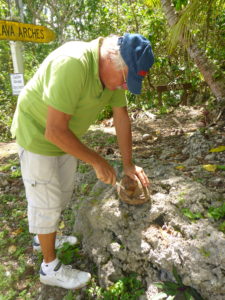
Walking through another lovely limestone rock garden I dipped into the half coconut Rob was holding for small chunks of the sweet white flesh and chewed and sucked on it as we walked to the Talava Arches.
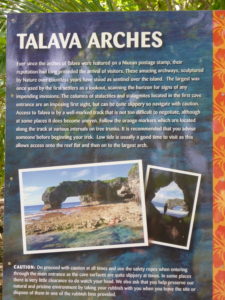
Like so many of the places on the island we had them to ourselves. By coincidence Andrea and Mark were coming away from them so we had another nice chat.
Forty five minutes later and having scrambled over rock, holding a rope for the last part we were rewarded by a flat area of limestone reef set within an archway of rock through which we could see the raging ocean. From rage to complete shelter we languished on smooth rock a few feet above the reef and soaked in the view for future reference.
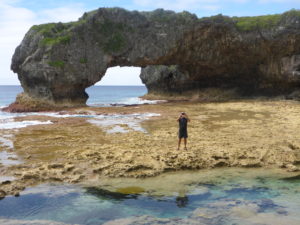
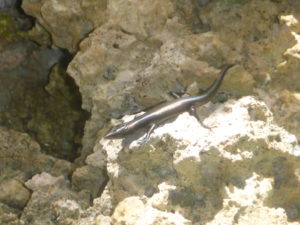
Back at the car park Werner knocked a ripe papaya from a tree and we sucked welcome sweet moisture from the flesh. What a provider, dear Werner.
Today we have had squalls on the mooring. We sat on our bed in the aft cabin and watched the rain running down the saloon windows as if it was being poured from a bucket. First all down one side and then as Zoonie rolled with the wind, it poured all down the other side.
As the wind howled I noticed the tender, suspended on a halyard clear of the water and at window height, was tipped onto its side where the wind caught it underneath and the oars about to be plopped into the sea. Poor Rob returned dripping from the minute or two it took to retrieve them.
Three boats arrived early, no doubt glad to be moored up in time for the blow. It looks like this weather will continue for a while. We hope to clear out tomorrow and leave for Vavau on Saturday, but not before snorkelling around Zoonie and across to the reef a few metres away.
